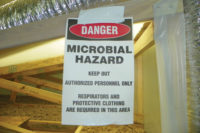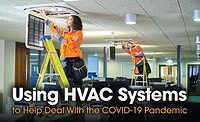How to Manage Indoor Air Quality Amid COVID-19

As we seek to return to normalcy without a vaccine, COVID-19 confronts us with a troubling reality. We spend 90% of our time indoors in the U.S. and Europe, and scientific evidence indicates we are nearly 20 times more likely to be infected by the virus indoors than outdoors. COVID-19 has impacted many indoor settings such as schools, offices, churches, restaurants and bars, with prisons, meatpacking plants, and long-term care facilities being most affected due to high occupancy, poor ventilation and vulnerable populations.
Increasingly, scientists believe airborne transmission is a major route for the spread of COVID-19. Viral respiratory droplets released from coughing, sneezing, talking, and breathing can aerosolize into smaller particles, stay suspended in the air for hours, and travel significantly farther than six feet. A key scientific debate has been whether the virus is infectious in aerosols.
Though the virus is clearly detectable in aerosols, no one had been able to provide evidence that it is “live” until the University of Florida. Skeptics of airborne transmission have been using this lack of evidence to challenge the importance of this mechanism. As the prominent aerosol scientist Linsey Marr said about the UF study, “If this isn’t a smoking gun, then I don’t know what is.” Even those who acknowledge aerosol’s infectiousness debate the relative importance of different viral transmission routes, including airborne or fomite, droplet or aerosol, direct or indirect contact, or a combination of mechanisms.
The role of airborne transmission of COVID-19 has a huge bearing on infection control in the built environment in two important respects. First, common approaches characterized by deep cleaning are incomplete and possibly misguided altogether. Second, masking and social distancing by themselves might be insufficient for mitigating airborne transmission.
Lisa Brosseau, a retired professor of public health, says that masks can limit larger particles’ spread, but they are less helpful for smaller particles. Aerosol mobility of over 30 feet, and suspension in air for hours can reduce the efficacy of six-foot social distancing mandates.

The fundamental question is what can and should we do to mitigate airborne transmission and create “safe” indoor environments amid COVID-19? One critically important and often overlooked area is engineering and Heating, Ventilation, and Air Conditioning (HVAC) controls. The American Industrial Hygiene Association (AIHA) states, “Engineering controls that can keep infectious aerosols at very low levels indoors offer the greatest promise to protect non-healthcare workers and other vulnerable populations as we reopen our businesses and workplace.”
Similarly, the American Society of Heating, Refrigerating and Air-Conditioning Engineers (ASHRAE) states, “Changes in building operations, including the operation of heating, ventilating, and air conditioning systems can reduce airborne exposures.” It highlights the following HVAC strategies based on evidence-based literature:
- Enhanced filtration that includes higher Minimum Efficiency Reporting Value(MERV) filters over code minimums in occupant-dense and/or higher-risk spaces
- Upper-room UltraViolet Germicidal Irradiation (UVGI), with possible in-room fans, as a supplement to supply airflow
- Local exhaust ventilation for source control
- Personalized ventilation systems for certain high-risk tasks
- Portable, free-standing High-Efficiency Particulate Air (HEPA) filters
- Temperature and humidity control
ASHRAE is careful to qualify its recommendations with the caveat that the system’s impact will depend on the source location, strength, and distribution of the released aerosol, droplet size, temperature, air distribution, humidity, and filtration. Each indoor environment is unique; conditions within each indoor environment are dynamic, and there is not a one-size-fits-all strategy for infection control.

Emerging technology by SafeTraces to evaluate engineering and HVAC systems for infection control.
The complex and evolving nature of the airborne transmission risk has resulted in two broad categories of responses for engineering and HVAC controls. The first is that owners and operators, particularly those responsible for mission-essential businesses, have spent significant financial resources on many of ASHRAE’s recommended strategies and beyond. The second category is many other owners and operators have done little due to being overwhelmed, confused, resource-constrained, or merely taking a wait-and-see approach.
Empirical data that allows people to understand the current level of risk and remediation usefulness is absent from most decision-making processes. ASHRAE, AIHA, IICRC and other leading authorities base their recommendations on evidence-based methodologies and peer-reviewed research.
Extrapolating academic studies results to any specific indoor environment has significant challenges and limitations, especially for a novel virus like SARS-CoV-2. ASHRAE and AIHA acknowledge as much, urging the involvement of knowledgeable mechanical engineers and industrial hygienists familiar with a building and, in some cases leveraging computational fluid dynamics (CFD) modeling.
However, mechanical engineers and industrial hygienists have candidly and consistently shared with us their concerns around infectious aerosols. Simply put, existing diagnostic solutions for indoor air quality, including tracer gases, smoke or bubble testing, and monitors or sensors may be insufficient for assessing the risk posed by an airborne pathogen like
SARS-CoV-2.
The good news is that emerging technologies at the cutting edge of building, health, and data science are posed to fill this gap. One notable solution is veriDART, developed by the Bay Area-based technology company SafeTraces with the National Institutes of Health (NIH) support. This groundbreaking technology safely mimics the airborne pathogen’s mobility with proprietary tracers based on the chemical composition, fluid dynamics, and detection methods of human saliva and aerosols that comply with OSHA, NIOSH, and ACGIH exposure limits. The key is to enable owners and operators to identify hotspots, assess filtration and ventilation, and inform remediations with empirical data, heatmap visualizations, and time-series analyses.
The challenge is how it efficiently support safer office reopening and emergency response at sites, yielding valuable data for what could be very costly engineering and HVAC control decisions. For example, a Fortune 500 company used veriDART for both a survey risk assessment of their 500,000 square foot office building and targeted risk assessments of their restrooms, conference rooms, and other perceived high-risk locations. A major focus area of testing was dilution ventilation, which ASHRAE and AIHA cite as an important engineering control for reducing an occupant’s exposure to airborne viruses.
It was established by veriDART data-driven time and condition parameters for tracer dilution to the diagnostic indicator level of low risk. Interestingly, the number of effective air changes per hour had a uniform effect on tracer dilution within a room, but non-uniform across rooms of similar size, HVAC configuration, and test conditions. The customer’s implication was clear: they needed to be careful about not over-generalizing their engineering and HVAC controls across the entire building.

veriDART solution measures time and HVAC setting parameters for dilution ventilation of aerosol particles.
Additionally, test results indicated mechanical issues, including exhaust systems not functioning properly and unexpected airflow between high-trafficked areas. In many cases, test results confirmed engineering and HVAC controls performed as expected. Ultimately, the user leveraged data to baseline their risk and inform tactical decisions regarding space utilization SOP’s, filtration enhancements, and procurement of airborne interventions prior.
Engineering and HVAC controls represent one of the most important opportunity areas for mitigating viral spread. However, there is no silver bullet strategy given each building’s uniqueness and constantly evolving conditions within the building. As management guru Peter Drucker famously said, “If you can’t measure it, you can’t improve it.” Assessing your risk through regular environmental monitoring and data-driven technology solutions will be hugely consequential for occupant health and safety, organizational productivity and liability, and development of infection control strategies that are both effective and financially sustainable.
References:
- https://www.medrxiv.org/content/10.1101/2020.02.28.20029272v2
- https://www.pnas.org/content/117/26/14857
- https://jamanetwork.com/journals/jama/fullarticle/2763852
- https://www.medrxiv.org/content/10.1101/2020.08.03.20167395v1
- https://www.technologyreview.com/2020/07/11/1005087/coronavirus-airborne-fighting-wrong-way/
- https://aiha-assets.sfo2.digitaloceanspaces.com/AIHA/resources/Guidance-Documents/Reducing-the-Risk-of-COVID-19-using-Engineering-Controls-Guidance-Document.pdf
- https://www.ashrae.org/file%20library/about/position%20documents/pd_infectiousaerosols_2020.pdf
- Ibid.
- https://cdn.ymaws.com/www.iicrc.org/resource/resmgr/images/resources/COVID-19_Professional_Cleani.pdf
Looking for a reprint of this article?
From high-res PDFs to custom plaques, order your copy today!







